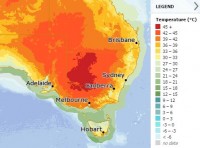Temperatures to reach mid-40s in inland NSW
13/01/2016

The Bureau of Meteorology is forecasting very high temperatures to continue in New South Wales and the ACT today (Wednesday).
Bureau of Meteorology Severe Weather Forecaster, Mr Michael Logan, said much of New South Wales was affected by severe to extreme heatwave conditions with temperatures to reach the low to mid-40s across many inland areas today.
“These unusually high temperatures are being caused by hot air from central Australia being dragged into New South Wales by north-westerly winds,” said Mr Logan.
Much of the Lower Western district is forecast to reach 45C today including Ivanhoe, Menindee and Lake Mungo.
Canberra is expected to reach 38C and Western Sydney 35C, while coastal parts of Sydney will escape the worst of the heat with 28C forecast for Sydney Observatory Hill.
“New South Wales and the ACT can expect to see relief on Thursday when a cool and gusty southerly change moves through the southern and western parts of the state during the day,” he said.
The Bureau now provides a Heatwave Service in addition to the temperature forecast, which provides a measure of the intensity of a heatwave, compared to the long term climate average.
Mr John Nairn said the Heatwave Service allows the Bureau to inform the community of the severity of a heatwave, and is able to map the level of intensity of each heatwave event.
“The current event shows large areas of Australia will reach severe heatwave conditions, a more advanced indicator than temperature alone in anticipating the impact of heat stress,” said Mr Nairn.
Severe and extreme heatwaves pose significant risks to human health and safety, particularly the elderly, who are more vulnerable to the effects of heat stress.
When temperatures are unusually hot over a period of time, with continuously high night-time and day-time temperatures, heat stress becomes a critical factor in human survival and infrastructure resilience.
Check the Bureau’s website for the latest weather forecasts and warnings, and follow us on Twitter.
Further information on the Bureau’s Heatwave Service for Australia can also be found on our website.










